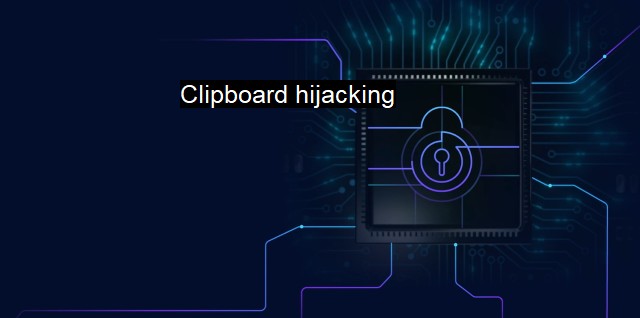What is Clipboard hijacking?
Clipboard Hijacking: The Rising Threat in Cybersecurity and How to Stay Protected
Clipboard hijacking is a potent cybersecurity threat that usually affects digital users at large. This kind of attack primarily involves the manipulation of the system clipboard – a software facility used for temporary storage and transfer of data between software or as part of the user interface. Clipboard hijacking is a kind of cyber-attack that is designed to gain unauthorized access to and control of a system's clipboard, hence the name "Clipboard hijacking".Most people use the clipboard function quite frequently. while copying a link, a piece of text, or an image from one place and pasting it into another. But what if someone was to secretly monitor this activity, manipulate the content you're transferring or even replace it with something harmful without your knowledge? That's essentially what Clipboard hijacking is all about.
In the world of cryptocurrency clipboard hijacking is a technique used by cybercriminals to alter the address to which digital currency is being sent. When a user copies the recipient's wallet address to transfer cryptocurrency, the malicious malware operating in the computer subtly changes the copied wallet address to the address of the hacker. Consequently, users might end up unknowingly sending their cryptocurrency to the thief pretending to be the vendor.
Clipboard hijacking presents an escalating threat in today's digital environment marked by an exponential increase of data sharing and online transactions. This technique is surreptitious due to its secretive nature and the fact that most users seldom manually verify the data they're pasting after copying. The absence of many perceptible signs of infection or interference makes noticing and combating clipboard hijacking intrinsically challenging.
Malicious hackers usually infuse the hijacking software in seemingly harmless email attachments or free software downloads. Once downloaded and installed, these applications run in the background and continually monitor the clipboard. A clipboard hijacker could also be packaged as a hidden bundled extra within other software, making identification and removal even more problematic.
Clipboard hijacking is not confined to compromising financial transactions or password theft only. Numerous incidences of clipboard hijackers used for propagating fake news, phishing attacks, spreading harmful content, and identity theft have been reported. Cybersecurity experts postulate that these trends could continue to grow owing to the relative simplicity of implementing such attacks and the broad, unprepared user base to exploit.
To counter the threat of clipboard hijacking, users should have robust antivirus software. Not only can this software locate, isolate, and expunge clipboard hijacking malware, but the best programs can also provide real-time monitoring of clipboard activity and block any suspicious changes. Periodically scrutinizing clipboard contents, particularly during digital transactions, and regularly updating software and antivirus databases to recognize the latest malware strains can go a long way in mitigating such threats.
Clipboard hijacking is a continually evolving cybersecurity threat that requires an awareness of the tactics hackers use and a proactive approach towards computer hygiene. Through the right tools and practices, digital users can fortify their defenses and ensure that the integral role of the humble clipboard in our daily digital lives is not used against us in nefarious ways.

Clipboard hijacking FAQs
What is clipboard hijacking?
Clipboard hijacking is a form of cyber attack in which attackers exploit the copy-paste function of users' computers to steal sensitive information such as login credentials, credit card details or personal data stored on the clipboard.How does clipboard hijacking work?
Clipboard hijacking works by replacing legitimate clipboard contents with malicious code or links whenever the user tries to copy and paste data. The malicious code can then be executed on the user's computer to initiate a cyber attack.How can I prevent clipboard hijacking?
To prevent clipboard hijacking, you should use an updated and reliable antivirus software that can detect and block malicious code. You can also disable automatic clipboard sharing in your system settings, avoid copying sensitive information and only use trusted websites and applications.What should I do if I suspect clipboard hijacking?
If you suspect clipboard hijacking, you should immediately close any suspicious windows or applications, run a malware scan with your antivirus software, change your login credentials, monitor your bank accounts, and contact your cybersecurity provider if you notice any unauthorized activity.| | A | | | B | | | C | | | D | | | E | | | F | | | G | | | H | | | I | | | J | | | K | | | L | | | M | |
| | N | | | O | | | P | | | Q | | | R | | | S | | | T | | | U | | | V | | | W | | | X | | | Y | | | Z | |
| | 1 | | | 2 | | | 3 | | | 4 | | | 7 | | | 8 | | |||||||